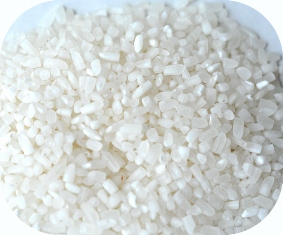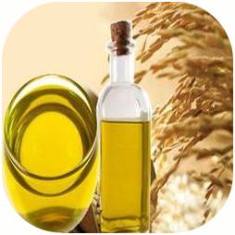BY PRODUCTS OF RICE
Broken rice
The broken rice is widely used in the food preparations and in the industries for making flour and in the manufacture of baby foods. The starch extracted from broken rice finds wider application in the pharmaceutical, textile and other industries.
Modernization of rice milling Industry also results in production of quality by-products viz., broken rice, husk and rice bran. Technology is now available for the production of value- added products from these by-products. |
 |
 |
Rice husk
Rice husk that contains about 38% cellulose and 32% lignin and is one of the most abundant renewable agriculture based fuel materials. The production of rice husk is about 80 million tonnes per year, equivalent in energy to about 170 million barrels of oil.
Paddy husk contains about 22 per cent ash of which 95 per cent is silica. Because of its high silica content, it is used as an abrasive. Large quantities of husk are used in India as fuel for boilers, kilns and household purposes.
|
Rice bran
Commercially rice bran is the most valuable by-product, which is characterized by its high fat (15 to 20%) and protein content. It also contains vitamins, minerals and many other useful chemicals. It is a potential source of edible oil. Because of its nutritional value, it is being used as feed for poultry and livestock.
More stable defatted bran containing higher percentage of protein, vitamins and minerals is an excellent ingredient for both food and feed. The bran is the most nutritious byproduct of rice milling and is used almost exclusively as a feedstuff. It is generally contaminated with husk, which lowers its nutritive value. Rice bran contains about 12 per cent protein and 15 per cent fat.
|
|
 |
Rice bran oil
Bran oil is obtained by the extraction of rice bran with solvents. Bran oil is also obtained in the solvent extraction milling of rice. The oil contains a high percentage of unsaturated fatty acids, yet it is quite stable because of the presence of natural antioxidants.
When refined, bleached and deodorized, it is used for salad dressing and as cooking oil. Bran after solvent extraction has a higher percentage of protein that the original material. With its low fat content it keeps well. |
Importance
Rice bran oil is the oil extracted from the germ and inner husk of rice. Rice bran oil is rich in vitamin E, γ-oryzanol(an antioxidant that may help prevent heart attacks) and phytosterols (compounds believed to help lower cholesterol absorption) which may provide associated health benefits. It has a mild taste and is popular in Asian cuisine because of its suitability for high-temperature cooking methods such as deep-frying and stir-frying. Rice bran oil is mostly monounsaturated - a tablespoon contains 7 grams of monounsaturated fat, three of saturated fat and five of polyunsaturated fat.
Rice bran oil also contains components of vitamin E that may benefit health. The unique components, such as oryzanol or tocotrienol, have been drawing people's attention. Numerous studies show rice bran oil reduces the harmful cholesterol (LDL) without reducing good cholesterol (HDL). In those studies, Oryzanol is reported as the key element responsible for that function. Tocotrienol, on the other hand, is highlighted as the most precious and powerful vitamin E existing in nature and is said to have an anti-cancer effect, too. As a Vitamin-E source, rice bran oil is rich not only in alpha Tocopherol but also has the highest amount of Tocotrienol in liquid form vegetable oils.
Uses
Rice bran oil is ideal oil for margarine and shortening. The flavor gives the good palatability and the desired prime form crystal provides smooth plasticity and spreading qualities. When processed to retain high levels of tocols, rice bran oil may be used as a natural antioxidant source for topically coating a wide range of products such as crackers, nuts, and similar snacks to extend shelf life.
|




